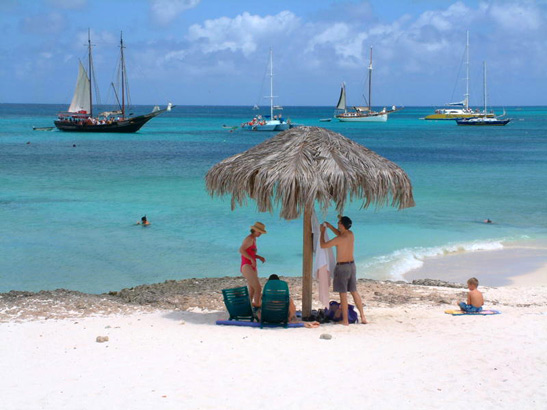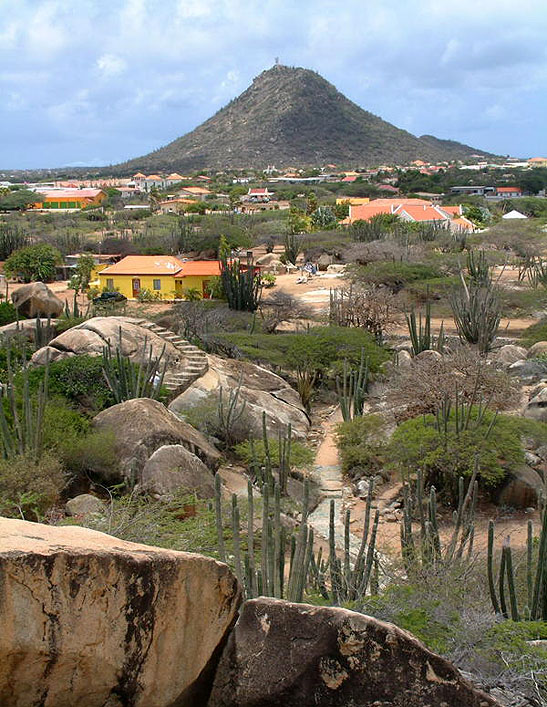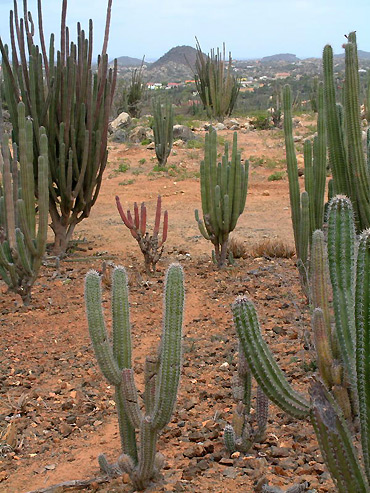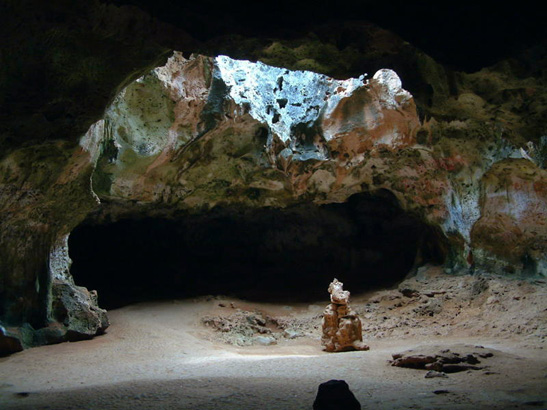 |
 |
|
 |

|
Magical
Aruba
The Everything Island By Ken Walker
It's the A of the ABC islands -- Aruba, Bonaire, and Curacao -- just 15 miles off the coast of Venezuela. Though only six miles wide and 20 miles long, it deserves a prime place on the A-list. What's great about it? For starters, there's the sun, the sand, the people, the terrain, the weather, the cuisine . . . And for those who enjoy finding fault, those same things can be problems. Round-trip airfare for a week in March 2010 ran a little over $500 from L.A. (It was under $375 from New York, $400 from Boston.) If you're cruising, who worries abiout the price? Once there, food and lodging run from cheap to indecently expensive, depending on your tastes. What makes everything seem possible is Aruba's limitless
variety: You might find these extremes anywhere, but in Aruba these extremes seem much further apart. And their variety challenges the imagination.
The Aruba sun is a faithful friend, but for the careless it's a scorching enemy. The sand is warm and soft, but when the wind is up it's a painful abrasive that can destroy a camera lens in seconds. The people (the locals) are hospitable and gracious in the face of tourist invasions, but the tourists themselves (yes, I have met them and they is us) can be insufferable in large doses.
The terrain is grandly varied and beautiful, but getting across the central outback is a tough hike or a rough ride without four-wheel drive. Many places resemble the desert Southwest of the U.S. The weather is usually an island-hopper's ideal. It can also get chilly at night and bone-baking hot in the noon-day sun. Did I mention the cuisine? In the capital, Oranjestadt,
you can easily imagine your restaurant is in New York, Paris, or Amsterdam.
In the countryside, simpler fare is the rule, with goat meat a staple.
And if you have an enquiring mind, you may be told that those white
chunks in the stew are tripe. Funny thing is, I don't like tripe, but
the stew was delicious. 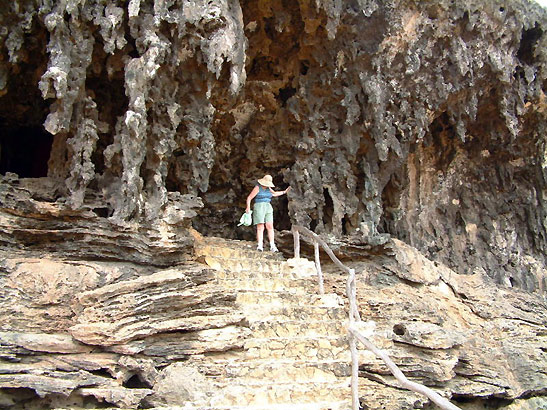 Cave entrance, Guadirikiri
Admittedly, most of the scenic splendors in Aruba other than ocean involve rocks. Beyond the mysterious glacial-type boulders of the Casibari area (no one knows how they got there), are special stony sights, both seaside and subterranean. Especially memorable are the Guadirikiri caves on the windward coast, where massive chambers open in volcanic basalt, one dark as a tomb, another sky-lit through a natural aperture in its ceiling. Ancient aboriginal rock paintings adorn the walls.
Another unique rock formation was a fearsome natural bridge of coral, connecting massive boulders above the erosive surf of the northern coast. You can still get photos of the bridge, but no one crosses it any more. The sea reclaimed it over a decade ago, yet it persists as a must-see on some Internet sites. Getting close to the rocks is simple at such sites as Baby Beach on the island's southeast tip, where captive sea-water from high-tide surf forms a large placid pool. There are beaches for all tastes, including one of unusual round black stones. Cultural attractions abound. A harbor full of cruise ships and sailing craft, a 200-year-old Dutch windmill shipped west and reassembled in Aruba 50 years ago, a bird sanctuary, museums, an abandoned gold mine and smelter, and the 260-year-old Alto Vista Chapel, the island's oldest house of worship. Want action? There's sailing, surfing, scuba and snorkel diving, jet-skiing, wind-surfing, deep-sea fishing, going below in a mini-submarine, golfing, and for those with thick jeans, sand-dune sliding. There are always more things to do than you have time for, and many of them can be enjoyed without money. One thing is certain. The Aruba experience can change
you. You leave with a renewed sense of wonder and a yen to return, to
find out if Aruba is really habit forming. |
|
Ken, amazing that pieces of this culture remain. Thanks for
sharing it with us.
Thank you, I so enjoyed reading about one of the remote ABC
island of delights...its an inspiration to bank on...and goat stew with tripe?...hmmmm.
Your story reads like a wondrous, exotic, nature fare to feast on for tourists!
Caves, desert, the old windmill and so many other things to do! Thanks Ken! * * * * Awesome photos Ken! You have a good eye--especially liked the
composition of your Hooiberg shot from the Casibari Rocks vantage point. Your
piece is excellent at portraying the range of potential tourist experiences
available in Aruba. And from your descriptions, it is fairly obvious you are
a very interesting guy who doesn't just stay on the beaten path...(anyone who
allows public viewing of that underwater portrait has my immediate respect!)
So I did find myself wondering...are you always this objective? I'd kind of
like to get a totally slanted version from someone like you!
|
This site is designed and maintained by WYNK Marketing. Send all technical issues to: support@wynkmarketing.com

|







 ant a break on a truly magical and mystical island, where everything
seems possible? You don't have to survive a plane crash and spend a
season among strange characters on TV. You just have to hop a plane
or cruise ship to Aruba.
ant a break on a truly magical and mystical island, where everything
seems possible? You don't have to survive a plane crash and spend a
season among strange characters on TV. You just have to hop a plane
or cruise ship to Aruba.